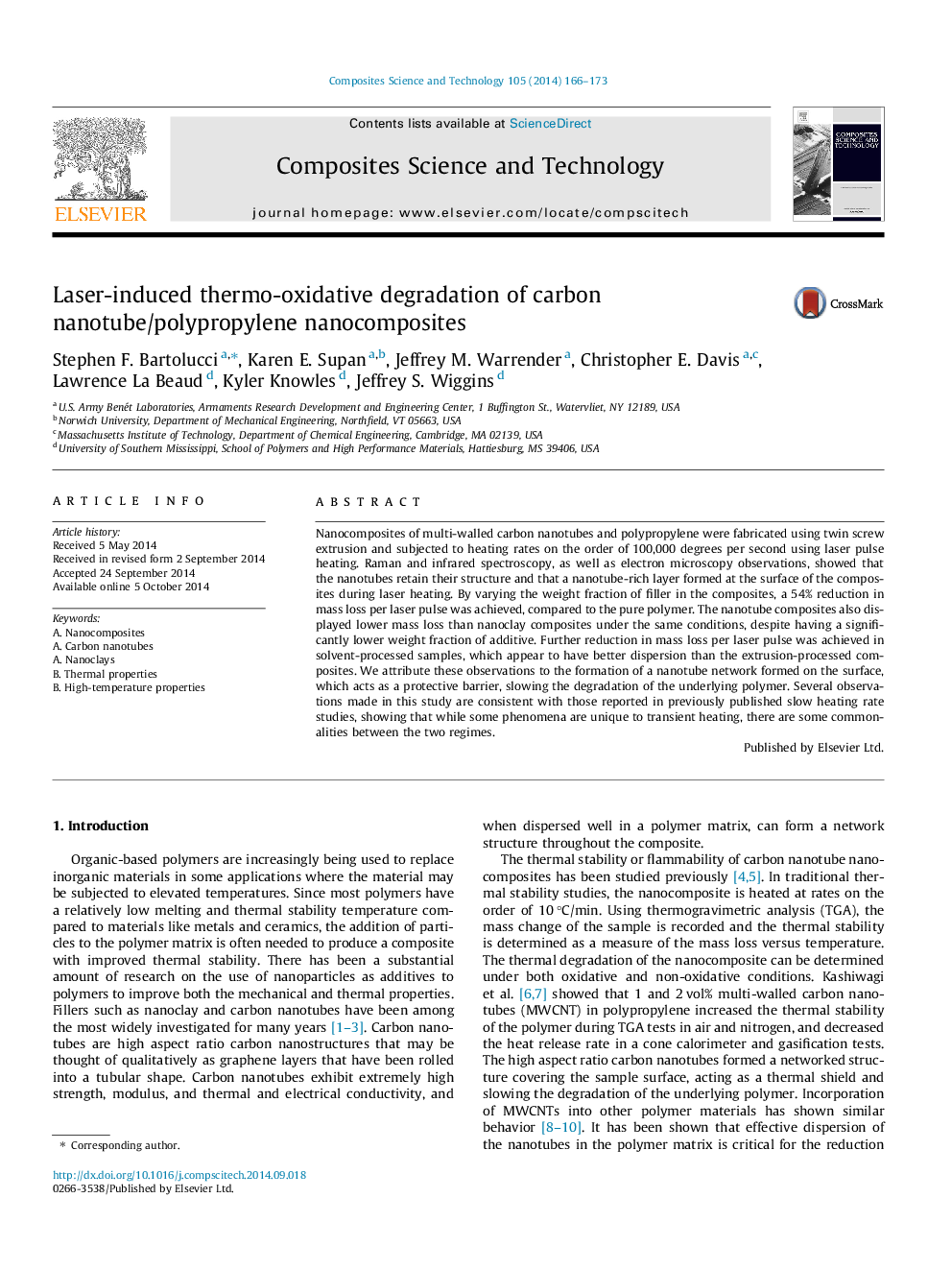| کد مقاله | کد نشریه | سال انتشار | مقاله انگلیسی | نسخه تمام متن |
|---|---|---|---|---|
| 7215669 | 1469520 | 2014 | 8 صفحه PDF | دانلود رایگان |
عنوان انگلیسی مقاله ISI
Laser-induced thermo-oxidative degradation of carbon nanotube/polypropylene nanocomposites
ترجمه فارسی عنوان
تخریب اکسیداتیو گرمایی ناشی از لیزر نانو کامپوزیت های نانولوله کربنی / پلی پروپیلن
دانلود مقاله + سفارش ترجمه
دانلود مقاله ISI انگلیسی
رایگان برای ایرانیان
کلمات کلیدی
ترجمه چکیده
نانوکامپوزیتهای نانولولههای کربنی چند جداره و پلی پروپیلن با استفاده از اکستروژن دوقلو ساخته شده و با استفاده از حرارت لیزر پالس لیزر به ترتیب 100000 درجه در ثانیه ساخته میشوند. طیف سنجی رامان و مادون قرمز، و همچنین مشاهدات میکروسکوپ الکترونی نشان داد که نانولوله ها ساختار خود را حفظ می کنند و لایه غنی از نانولوله ها در سطح کامپوزیت ها در طول گرمایش لیزری تشکیل شده است. با تغییر درصد وزن پرکننده در کامپوزیت ها، در مقایسه با پلیمر خالص، کاهش 54٪ کاهش وزن در هر پالس لیزر به دست آمد. کامپوزیت های نانولوله همچنین با کمترین وزن کم از افزودنی، تحت شرایط مشابه، کاهش وزن کمتری نسبت به کامپوزیت های نانو را به نمایش گذاشتند. کاهش بیشتر در کاهش تلفات در هر پالس لیزر در نمونه های پردازش حلال به دست آمد که به نظر می رسد پراکندگی بهتر از کامپوزیت های پردازش اکستروژن است. ما این مشاهدات را به شکل گیری یک شبکه نانولوله ای تشکیل می دهیم که بر روی سطح تشکیل شده است، که به عنوان یک مانع حفاظتی عمل می کند و باعث تضعیف پلیمر زیرزمینی می شود. مشاهدات متعددی که در این مطالعه انجام شده است، مطابق با مطالعات منتشر شده در مطالعات سرعت آهسته است که نشان می دهد که در حالی که بعضی از پدیده ها به گرمای گذرا منحصر به فرد هستند، برخی از این دو رژیم مشترک هستند.
موضوعات مرتبط
مهندسی و علوم پایه
سایر رشته های مهندسی
مهندسی (عمومی)
چکیده انگلیسی
Nanocomposites of multi-walled carbon nanotubes and polypropylene were fabricated using twin screw extrusion and subjected to heating rates on the order of 100,000 degrees per second using laser pulse heating. Raman and infrared spectroscopy, as well as electron microscopy observations, showed that the nanotubes retain their structure and that a nanotube-rich layer formed at the surface of the composites during laser heating. By varying the weight fraction of filler in the composites, a 54% reduction in mass loss per laser pulse was achieved, compared to the pure polymer. The nanotube composites also displayed lower mass loss than nanoclay composites under the same conditions, despite having a significantly lower weight fraction of additive. Further reduction in mass loss per laser pulse was achieved in solvent-processed samples, which appear to have better dispersion than the extrusion-processed composites. We attribute these observations to the formation of a nanotube network formed on the surface, which acts as a protective barrier, slowing the degradation of the underlying polymer. Several observations made in this study are consistent with those reported in previously published slow heating rate studies, showing that while some phenomena are unique to transient heating, there are some commonalities between the two regimes.
ناشر
Database: Elsevier - ScienceDirect (ساینس دایرکت)
Journal: Composites Science and Technology - Volume 105, 10 December 2014, Pages 166-173
Journal: Composites Science and Technology - Volume 105, 10 December 2014, Pages 166-173
نویسندگان
Stephen F. Bartolucci, Karen E. Supan, Jeffrey M. Warrender, Christopher E. Davis, Lawrence La Beaud, Kyler Knowles, Jeffrey S. Wiggins,
